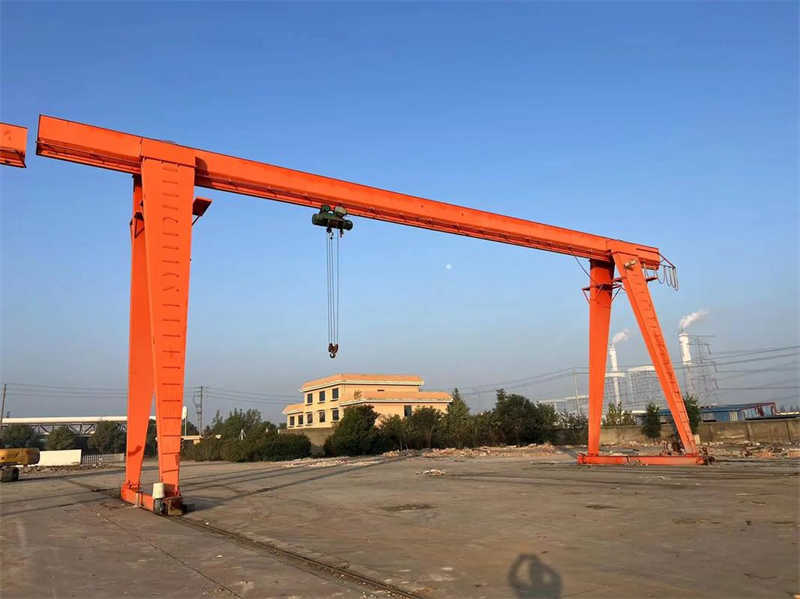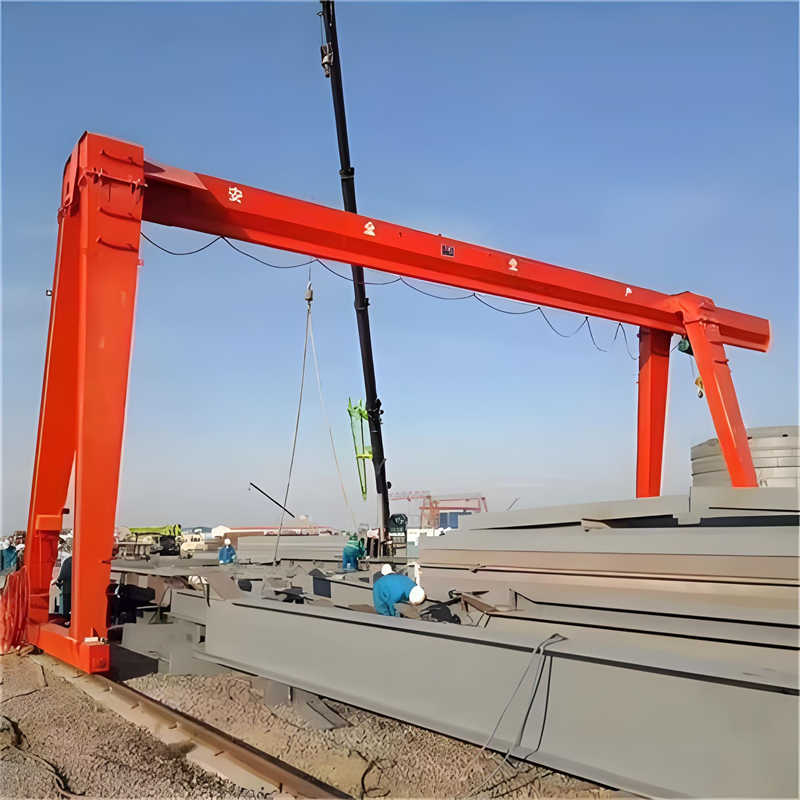2-Apr-2025
10 Ton Gantry Crane
Introduction to 10 Ton Gantry Cranes
A 10 ton gantry crane is one of the most versatile material handling solutions for industries requiring heavy lifting capabilities. Whether you’re looking for a 10 ton gantry crane for sale or researching 10 ton gantry crane price ranges, this comprehensive guide covers everything you need to know about these powerful lifting systems.
Unlike standard overhead cranes, gantry cranes offer freestanding support structures that don’t require building modifications, making them ideal for both indoor and outdoor applications. Let’s explore the different types, key features, industrial applications, and pricing factors to help you make an informed purchase decision.
Types of 10 Ton Gantry Cranes (Detailed Comparison)
1. Fixed Height vs. Adjustable Gantry Cranes
Fixed Height Gantry Cranes
- Structure: Permanent, non-adjustable framework with a fixed beam height.
- Load Capacity: Typically rated for 10 tons but can vary based on design.
- Installation: Requires precise measurement before setup since height cannot be altered.
- Stability: More rigid and stable due to fixed construction.
- Best For:
- Dedicated workstations with consistent lifting requirements
- Production lines where load height remains unchanged
- Facilities needing long-term crane positioning without adjustments
Pros:
✔ Lower initial cost (no adjustable mechanisms)
✔ Stronger structural integrity (fewer moving parts)
✔ Minimal maintenance (no height-adjustment components)
Cons:
✖ Inflexible—cannot adapt to different load heights
✖ Requires precise initial setup
✖ Not suitable for multi-height applications

Adjustable Gantry Cranes
- Structure: Features telescoping legs or hydraulic/pneumatic height adjustment.
- Load Capacity: Maintains 10-ton rating but stability may vary at maximum extension.
- Adjustment Mechanism:
- Manual (pin-lock or screw-based adjustment)
- Motorized (electric or hydraulic height control)
- Best For:
- Facilities handling varying load heights (e.g., different-sized containers)
- Maintenance and repair shops needing flexible lifting solutions
- Temporary or relocatable workstations
Pros:
✔ Adaptable to different lifting requirements
✔ Ideal for multi-purpose workshops
✔ Some models allow on-the-fly adjustments
Cons:
✖ Higher initial cost (adjustment mechanisms add complexity)
✖ Slightly reduced stability at maximum extension
✖ Requires periodic maintenance of adjustment systems
2. Manual vs. Powered Operation Systems
Manual Push-Beam Gantries
- Operation: Requires physical pushing/pulling to move the crane along the floor.
- Hoisting: Typically uses a manual chain hoist or lever-operated lift.
- Best For:
- Low-budget operations
- Light to moderate lifting frequency
- Workshops with limited electrical access
Pros:
✔ Lowest cost option
✔ No power dependency (usable in remote locations)
✔ Simple maintenance (no motors or electrical parts)
Cons:
✖ Labor-intensive (requires operator effort)
✖ Slower operation (not ideal for high-productivity environments)
✖ Limited precision in load positioning
Electric-Powered Gantry Cranes
- Operation: Motorized travel (along rails or wheels) and electric hoisting.
- Control Options:
- Pendant control (wired remote)
- Radio remote (wireless operation)
- Cabin-operated (for large industrial models)
- Best For:
- High-frequency lifting operations
- Production lines requiring speed and precision
- Heavy-duty industrial applications
Pros:
✔ High efficiency and productivity
✔ Smooth, precise load handling
✔ Reduced operator fatigue
Cons:
✖ Higher initial and operational costs
✖ Requires electrical infrastructure
✖ More complex maintenance (motors, controls, wiring)
3. Specialty Gantry Crane Variants
Explosion-Proof Gantry Cranes
- Design:
- Spark-resistant motors and electrical components
- Non-corrosive materials (stainless steel or special coatings)
- Certifications: ATEX, IECEx, or other hazardous location ratings.
- Best For:
- Oil refineries, chemical plants
- Gas storage facilities
- Mining and explosive manufacturing
Pros:
✔ Safe operation in volatile environments
✔ Complies with strict industry regulations
Cons:
✖ Significantly higher cost than standard models
✖ Limited supplier availability
Low-Headroom Gantry Cranes
- Design:
- Compact hoist and trolley system
- Reduced vertical clearance between beam and hook
- Best For:
- Facilities with low ceilings (e.g., underground warehouses)
- Assembly lines with height restrictions
Pros:
✔ Maximizes usable workspace
✔ Ideal for constrained environments
Cons:
✖ Limited lifting height
✖ May require custom engineering
Outdoor-Rated Gantry Cranes
- Features:
- Weatherproof construction (IP65 or higher)
- Corrosion-resistant coatings (galvanized or epoxy paint)
- Wind-resistant bracing (for high-wind areas)
- Best For:
- Shipyards, ports
- Construction sites
- Lumber yards and steel fabrication
Pros:
✔ Durable in harsh conditions
✔ Long service life with proper maintenance
Cons:
✖ Higher cost due to protective features
✖ Requires periodic corrosion inspections

Final Comparison Summary
| Feature | Fixed Height | Adjustable | Manual | Powered | Explosion-Proof | Low-Headroom | Outdoor-Rated |
|---|---|---|---|---|---|---|---|
| Cost | Low | Medium-High | Low | High | Very High | Medium | Medium-High |
| Flexibility | Low | High | Low | High | Low | Medium | Medium |
| Maintenance | Low | Medium | Low | High | High | Medium | High |
| Best Environment | Fixed stations | Variable needs | Budget ops | High-speed | Hazardous zones | Low ceilings | Harsh weather |
Which One Should You Choose?
- Need flexibility? → Adjustable or powered models
- Working in hazardous areas? → Explosion-proof
- Limited budget? → Fixed height or manual push-beam
- Outdoor use? → Weather-resistant outdoor models
This detailed breakdown helps in selecting the right 10-ton gantry crane for your specific operational needs. 🚀
Key Features That Impact Performance
When evaluating 10 ton gantry cranes for sale, these critical features determine suitability:
Structural Components
- Box Girder vs I-Beam Construction: Box girders offer greater stiffness for precision lifts
- Dual-Hoist Configurations: Allow simultaneous handling of different load sizes
- Span Width Options: Standard 5-20m spans with custom wider configurations available
Control & Safety Systems
- Variable Frequency Drives: Enable smooth acceleration/deceleration
- Overload Protection: Automatic shutdown at 110% capacity
- Anti-Collision Systems: Essential for multiple crane operations
Mobility Options
- Fixed Base: Bolted to foundation for permanent installations
- Wheel-Mounted: Locking casters for semi-permanent positioning
- Rail-Guided: For precise movement along fixed paths
Industry-Specific Applications
Manufacturing Facilities
- Automotive Plants: Engine block transfers (8-10 ton typical weights)
- Steel Service Centers: Coil handling with C-hook attachments
- Precision Machinery: CNC equipment installation/relocation
Construction & Infrastructure
- Bridge Projects: Precast concrete segment handling
- Power Plant Maintenance: Turbine generator servicing
- Urban Development: Modular building component placement
Logistics Operations
- Container Depots: 20′ ISO container handling (empty ~2.2 tons, loaded up to 30 tons)
- Heavy Equipment Warehousing: Bulldozer/Excavator component storage
- Aerospace Logistics: Aircraft part transportation
10 Ton Gantry Crane Price Breakdown
Base Price Ranges (2024 Market)
- Manual Gantry Systems: $8,000 – $18,000
- Standard Electric Models: $22,000 – $45,000
- Custom Heavy-Duty Units: $50,000 – $120,000+
Key Cost Factors
- Structural Materials: Carbon steel vs alloy steel pricing
- Hoist Specifications: Wire rope vs chain hoist options
- Automation Level: Basic pendant vs radio remote controls
- Certifications: CE/ASME compliance adds 15-25% to base cost
Hidden Cost Considerations
- Installation Fees: $2,000 – $10,000 depending on complexity
- Annual Maintenance: ~3-5% of purchase price for service contracts
- Energy Consumption: Electric models average $500-$1,200/year in power costs
Purchasing Considerations
When sourcing 10 ton gantry cranes for sale, evaluate:
✅ Load Testing Documentation: Verify third-party certification
✅ Warranty Coverage: Look for 3-5 year structural warranties
✅ After-Sales Support: Availability of local service technicians
✅ Future Expansion: Modular designs that allow capacity upgrades
Conclusion
Selecting the right 10 ton gantry crane requires careful analysis of your specific lifting needs, facility constraints, and budget parameters. While 10 ton gantry crane prices vary significantly based on configuration, investing in quality equipment from reputable manufacturers ensures long-term reliability and safety.
For buyers comparing options, we recommend:
- Requesting load test videos from suppliers
- Visiting local facilities with similar cranes in operation
- Getting multiple quotes with detailed specifications
Need expert guidance on your gantry crane purchase? Contact our lifting specialists today for personalized recommendations and competitive pricing on 10 ton gantry cranes for sale.

